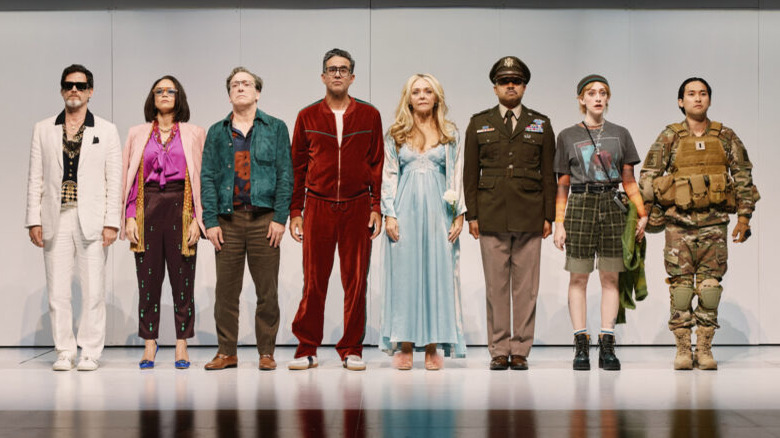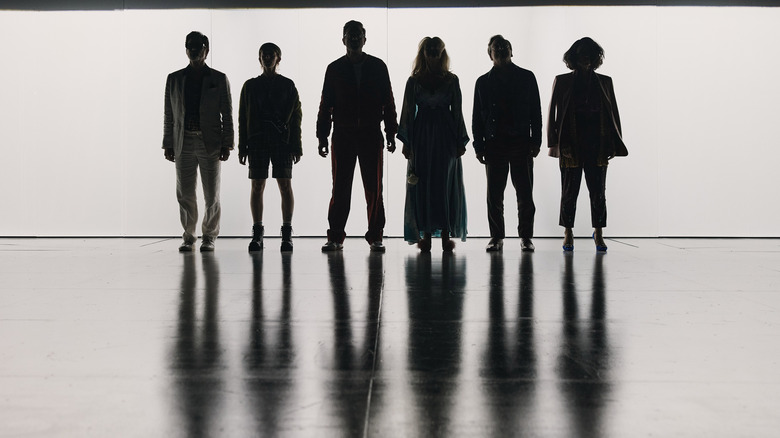Here We Are Review: Stephen Sondheim's Swan Song Musical Is A Twilight Zone Ride
Disclaimer: These impressions are based on a preview while the show was still in progress before opening night. This review will spoil the show's surrealist imagery.
And so au revoir to the era of the composer-lyricist Stephen Sondheim, whose touches wander his posthumous (half-)musical "Here We Are," his long-gestating collaboration with playwright David Ives. Sondheim's swan song (originally developed at the Public Theater and titled "Square One") may prove to be a divisive epilogue, and this is aside from the think pieces about the artistic ethics of presenting the unfinished pieces (reports say Sondheim signed off on the musical's staging). Regardless, it is a production that snags your attention. If unfamiliar with the two Luis Buñuel surrealist films that inspired it, viewers may deem the darkly comic "Here We Are" as "Sondheim's Twilight Zone" musical (next to the 1966 televised "Evening Primrose").
When entering the 526-seat theater of the Shed, two domestic servants (Tracie Bennett and Denis O'Hare, rotating seamlessly around servant-servers roles) polish the purgatorial boxed white of the thrust stage, flicking on the vacuum and occasionally stealing a cigarette break. The mirror panels on the side walls marginally aid the scenery for the obstructed-view side audience (many of whom may have scored the $40 rush).
Then enter a party of six bourgeoisie hunting for brunch. Among them is the cheerful Marianne Brink (a dreamy Rachel Bay Jones), donning a baby blue satin nightgown on the adventure, a hint that this journey plays loose with logic. She and her moneyed husband, Leo Brink (Bobby Cannavale), are uber-rich enough to prattle about cloning their poodles so that their clone canines will wait for them at their vacay spots. They're joined by Marianne's socialist sister, Fitz (Micaela Diamond of "Parade" fame, making the best of a so-far underdeveloped role). She's enjoined to the party for the purpose of declaring that "the revolution" will wreak retribution on their one-percenter hedonism, though she may be more assimilated into the bourgeoisie than she would like to admit. Marianne and Fitz aren't the centerpoint in the ensemble, among the upper-crust caricatures (Amber Gray's hammy Claudia; an affable Jeremy Shamos's Paul, Claudia's seemingly oblivious hubby; Steven Pasquale's Raffael, an Italian lover stereotype), but they operate as the ideal foils to speculate on the open-to-interpretation ideas of "Here We Are."
A Buñuel's road adventure
In "Act One: The Road" (Buñuel's "The Discreet Charm of the Bourgeoisie"), surrealist incidents prevent the party from satisfying their appetites. A "Cafe Everything" ran out of food; the next restaurant has weeping waiters holding a wake for a dead chef (his corpse spread out on a dining table in among the show's first laid-out shocks); and a third restaurant serves fake food. And that's glossing over other oddities in between. Outside, war gunfire punctures the air (sound design by Tom Gibbons), and Fritz has "the revolution" on speed dial and schemes to cue it into the brunch room.
The thrill of this Buñuel-based musical is how so little is explained, leaving riddles for the audience that could hit various wavelengths. It's a roadmap that director Joe Mantello ("Wicked" and "The Grey House") draws out through striking portends (with Sam Pinkleton's purposefully repetitious travel choreography). New players, like Francois Battiste's Colonel Martin, drop in. In his magnetic role of the "Soldier," Jin Ha joins the party with a sustained number about a bizarre dream involving sheep and a brief shattering of the fourth wall. Subsequently, a heaven-sent David Hyde Pierce bubbles the stage with his charms as the klutzy Bishop who is looking for a job — even a gardening position — to feel useful.
Underneath Natasha Katz's lighting, David Zinn's set designs lay bare the abstract intrigues through variants of art styles. Across the Sondheimic plink-pla-plink (orchestrated by Sondheim collaborator, Jonathan Tunick), Zinn's costumes also sing their own songs about the cast's respective idiosyncrasies, from Fritz's militant plaid shorts, to the burgundy tracksuit of Cannavale's Leo, to the satin chic of Claudia's apparel (rounded out by Robert Pickens and Katie Gell's hair and make-up work).
In "Act Two: The Room" (Buñuel's "The Exterminating Angel"), the songs literally fade out. The party settles down in an antiquated study (Zinn's unsparing set), only to discover that a cryptic force compels them to never leave the space. Insanity and secrets spill out. Most of the human center and colorful performances shower Act Two, as the rich face the specter of mortality. Cannavale's manly bombast burns through in a bid for confidence when his body weakens ("I'll take over Hell and turn it into condos," he whoops). The MVP is O'Hare, an "American Horror Story" alum, a servant who harnesses his newfound dominance over his employers, browbeating them to reduce themselves to all fours and ba like sheep for treats.
'The End of the World...'
You detect that the incomplete formation of "Here We Are" isn't just a textual feature (it's about people who are incomplete, after all), but also a bug. While Sondheim's alliterative habits and rhymes can be recognized, his numbers can feel like drafts a few revisions away from the bar he has set. Due to Sondheim's passing, few songs also begin Act Two before underscored motifs take over the rest of the show. Theoretically, the exit of songs shouldn't strike as anomalous in the second half (as the Bishop laments in-universe, "The piano died," over the instrument that has lost its tune), but the chasms leave wanting. Having the composer-lyricist no longer in the room for tinkering, time will tell how later stagings bridge the missing pieces.
Even as Ives seems to be figuring out adrift character plot threads, his text provides a plumage of wordplay and the satirical banter for a sustainable play. To Marianne (who stays ditzy but matures into a more curious being), Pierce's Bishop spells out the show's simplest reading: "We are here. Until we are not." He suggests that makes life — in all its absurdities and horrors — worth living. You might sense that had Sondheim had more years, he would have spun lyrical gold for Pierce and Jones.
When order appears to be restored, the Bishop's words may nudge the cynical "Here We Are" an inch toward the optimism of "Into the Woods." Yet, this idealistic sunbeam is eclipsed by the finale of noise, gesturing toward grander world affairs that threaten to crumble down their insular comforts. Even though few, like Marianne, may emerge slightly different than before, their epiphanies may get swallowed by the world. This is a show about a bourgeoisie bubble that — for now — can afford distractions and sweep aside the questions some other time. Here they are, re-seeking pleasures, with their grins and anticipation melting like wax from the candle. Although "Here We Are" leaves you hungry for completion, it's a slow-crawling nightmare that plink-pla-plink in your consciousness long after you leave the theatre.
"Here We Are" is playing off-Broadway at The Shed in New York City. It is scheduled to run until January 21st, 2024.


